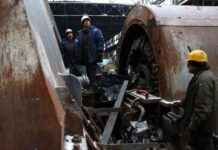The Young Forum of the German-Israeli Society (DIG) was certain: “Anti-Semitism partially pasted over – another scandal at the Documenta”. At the world art exhibition in Kassel, the activists noticed a joint work by the Indonesian artist collective Taring Padi and the North American artist initiative Justseeds. It shows four people dividing bags of money among themselves. In addition to the insignia of power and wealth, a person is endowed with other characteristics that correspond to anti-Semitic stereotypes: a long nose, bulging lips and a malicious grin.
And the person wears a hat that was altered in Kassel with a black strip of tape. On the original work, this headgear looks like a kippah. “The motif described clearly uses centuries-old anti-Jewish resentment,” wrote the author of this text in a WELT comment. At the Young Forum of the DIG it was said: “Again the caricature of a greedy, long-nosed Jew appears at the Documenta, which is unmistakably known from National Socialist publications.”
The artistic direction of the documenta, the curator collective Ruangrupa, has now published a contextualization of the work. Originally, it was an Arabic Kufi hat that was “modified into a clearer Indonesian Songkok hat”. “To prevent further misunderstandings,” a member of Taring Padi stuck on the new headgear during the ongoing Documenta. The work was created to criticize exploitation in mining. The criticized excerpt is intended to represent the religious leadership in Indonesia.
The explanation seems plausible. The collective of curators explains in detail what role the kufi hat plays in Indonesian clothing culture. If it really wasn’t Jewish headgear, both the Young Forum of the DIG and the author of this text made a misinterpretation based on the information available at the time, since both spoke of a kippah. However, the other details are still to be interpreted as anti-Semitic stereotypes. They are central features of anti-Jewish caricatures.
In view of this renewed confusion, one has to ask why the communication about the documenta only begins when something has become a scandal. Why didn’t the curatorial collective itself communicate with the relevant bodies and associations if they were actually concerned about a possible misinterpretation? And how is it that the committee of experts on the subject of anti-Semitism set up by the Documenta shareholders was not informed that the work was partially taped over? Wasn’t this body specifically set up to investigate indications of possible anti-Semitic imagery?
Nicole Deitelhoff, chair of the committee and head of the Leibniz Institute Hessian Foundation for Peace and Conflict Research, told WELT AM SONNTAG: “The committee was neither informed about the pasting over nor about the removal of works from the exhibition if they were removed in a targeted manner. Both are completely inappropriate with regard to dealing with the problem of anti-Semitism in these works and massively hinder the work of the committee.
The unusual intervention of masking also raises further questions. Ruangrupa explains it like this: “Every artist is free to paint, glue or otherwise edit his or her work.” artistic direction had found “that the previous handling, including the pasting over, gave rise to misunderstandings”.
The Documenta has to be asked again and again why an expert committee on the subject of anti-Semitism is used if this commission is not even informed about current incidents. And why the visitors of the exhibition are apparently supposed to be deceived about the full extent of the anti-Semitism scandal. At the end of July, a chance find revealed that a brochure with clearly anti-Semitic content had been exhibited at the Documenta. An Algerian women’s initiative showed an Israeli soldier with a hooked nose.
The affected page of the brochure is now missing. A cardboard cutout by Taring Padi depicting an Indonesian military man with a dollar sign and a speech bubble that says “Hoax” and a six-pointed star on his lapel resembling a Star of David is also no longer on display in Kassel. It is a legitimate demand that such exhibits should be removed from the Documenta. However, transparent dealings also include not simply doing this quietly and secretly. Otherwise, the process looks more like a cover-up of the problem.








